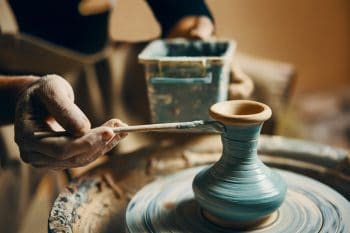Creative Healing Power In Recovery

How Creative Healing Impacts Addiction Recovery
The impact creativity has had on communities recovering from drug use has been positive. Rehab facilities offer unique approaches to healing for adequate emotional growth and work better with patients who have support and utilize 12-Step ideologies. The American Arts Association states art therapy would help to increase someone’s belief in the first step of the 12-Steps, graduating to a deeper understanding of the first 3 steps post-art therapy.
Creativity helps patients put what they may not be able to discuss in a visual form. Moreover, practicing creativity in rehab facilities cuts through shame and guilt; stabilizes emotions; allows individuals to process grief in a constructive manner; produces pleasure and joy; allows someone to live in the moment and disconnect from obsessive ruminations; shift his or her focus to the present moment and engages someone to identify emotions in an abstract form to convert into words.
Art and music therapists are on-site to guide patients recovering from substance abuse-related conditions, patients with co-occurring disorders (also called dual diagnosis when a mental condition and drug abuse is present) and help them unleash what is suppressed. Patients can focus on the positives in life as they use the power of art, dance, song, and drama to find a source of strength and focus.
Healing Emotions With Creative Therapies
Expressing our inner-most emotions can feel liberating, whereas the inability to release important emotions can result in stress, compulsion, anxiety, depression, and other conditions. Fortunately, individuals seeking recovery for chemical dependences have the options to heal with both traditional methods, and use innovative treatments inspired by art. Expressing and healing through music, art, dance, writing, or sculpture has had a positive effect on the recovery process. It provides an increase in self-confidence in the ability to communicate difficult emotions. The spectrum of creativity in conjunction with recovery includes but is not limited to:
- Art therapy
- Writing/journaling
- Dancing
- Sculpting
- Art therapy
- Music therapy
- Drama therapy
Since emotions allow us to remain clear of our motivations and sometimes inspire us to make decisions, they are important elements to engage our creative side. In cases of drama therapy, someone can re-enact painful moments or memories to express trauma. Secondly, individuals can re-connect with their emotional body in a healthy way. He or she is using the power of creativity, the person is able to access emotions that can be hidden or motivations for unhealthy behaviors. Music therapy is evidence-proven therapy that utilizes the power of instruments and vocals as well as music lyrics to help the individual achieve their therapy goals. It functions to soothe and heal depression, anxiety, guilt and shame, and can be combined with other forms of therapy for increased results.
PTSD, Music And Art Therapy In Recovery
Practicing dance therapy, music therapy, art therapy, and writing therapy practices, for example, can help regulate difficult emotions. The ability to paint feelings into a tangible and beautiful piece of artwork can greatly help someone battling anxiety, Post-Traumatic Stress Disorder (PTSD), and relax tense moods. To illustrate, art therapy has been vital in reducing symptoms of anxiety and individuals battling PTSD where venting or other methods of therapy have been less effective.
Art or music therapy allows them to relax and feel safe, which is important for communication. It allows each person to put emotions in a tangible form without having to open up and become vulnerable to being judged. Lastly, creativity would encourage individuality and empowerment through positive changes.
The Connection Between Creativity and Drug Use
The power of creativity has long been used to bring healing and transformation to the lives of many. Furthermore, healing through creativity has been associated with aiding in the creative process. For example, many believe consuming alcohol can increase one’s writing or painting abilities; hence the connection between writers and drinking.
Opium has been used by notable artists in the 17th century and painters may have experimented with hallucinogens to inspire vivid images. Through history and specifically in the 1960s, artists believe in the powers of LSD to allegedly help increase creativity. As a result, many became addicted to the drug and may have endured psychotic breaks, resulting in dependencies. There are several other instances that reveal the connection between writers, artists, or musicians and substances. These examples cite a power and driving force in creative expression.
Healing Through Creativity in Rehab
Emotions must be worked through and nurtured during the rehabilitation process. Emotions can be at their most raw points when someone is trying to surrender addiction. Currently, rehab facilities offer holistic and unique treatments. Traditional treatment methods, such as medication and support groups have been helpful in maintaining healings for individuals with a substance abuse disorder. Those who are more vulnerable to substance abuse, such as writers or artists facing depression and anxiety, or individuals with a history of substance abuse may find it more beneficial as they are of interest to these groups.
Ready To Get Help?
Rehab facilities offer a variety of healing methods for all types of people and all types of creative care. To discover how creativity can heal, contact a treatment provider today. Don’t waste another second. Call now to speak with a compassionate treatment provider.